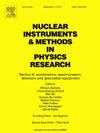Innovative resistive plate chambers for the CMS phase-2 upgrade: Project summary, construction, and quality assurance
IF 1.5
3区 物理与天体物理
Q3 INSTRUMENTS & INSTRUMENTATION
Nuclear Instruments & Methods in Physics Research Section A-accelerators Spectrometers Detectors and Associated Equipment
Pub Date : 2025-04-05
DOI:10.1016/j.nima.2025.170453
引用次数: 0
Abstract
In view of the Phase-2 of the LHC physics program, called High Luminosity LHC (HL-LHC), the CMS muon system will be upgraded to maintain a robust muon triggering and reconstruction performance. Therefore RE3/1 and RE4/1 stations of the forward muon system will be equipped with new improved Resistive Plate Chambers (iRPC) as dedicated detectors for muon triggering in CMS. The new iRPC detectors have a different design and geometry with respect to the present RPC system to improve the rate capability and survive the harsh background condition during HL-LHC. This work summarizes the iRPC project including the iRPC design and production process, details of the ongoing detector production, quality control procedures at the production sites and results of performance studies with high energy muon beam under intense gamma radiation at the CERN Gamma Irradiation Facility (GIF++) facility.
CMS二期升级创新电阻板室:项目总结、施工及质量保证
鉴于LHC物理计划的第二阶段,即高亮度LHC (HL-LHC), CMS μ子系统将进行升级,以保持强大的μ子触发和重建性能。因此,向前μ子系统的RE3/1和RE4/1站将配备新型改进的电阻板室(iRPC)作为CMS中μ子触发的专用探测器。新的iRPC探测器有一个不同的设计和几何相对于目前的RPC系统,以提高速率能力和生存在HL-LHC期间恶劣的背景条件。本文总结了iRPC项目,包括iRPC的设计和生产过程、正在进行的探测器生产的细节、生产现场的质量控制程序以及在CERN伽玛辐射设施(GIF++)设施中高能介子束在强伽玛辐射下的性能研究结果。
本文章由计算机程序翻译,如有差异,请以英文原文为准。
求助全文
约1分钟内获得全文
求助全文
来源期刊
CiteScore
3.20
自引率
21.40%
发文量
787
审稿时长
1 months
期刊介绍:
Section A of Nuclear Instruments and Methods in Physics Research publishes papers on design, manufacturing and performance of scientific instruments with an emphasis on large scale facilities. This includes the development of particle accelerators, ion sources, beam transport systems and target arrangements as well as the use of secondary phenomena such as synchrotron radiation and free electron lasers. It also includes all types of instrumentation for the detection and spectrometry of radiations from high energy processes and nuclear decays, as well as instrumentation for experiments at nuclear reactors. Specialized electronics for nuclear and other types of spectrometry as well as computerization of measurements and control systems in this area also find their place in the A section.
Theoretical as well as experimental papers are accepted.

 求助内容:
求助内容: 应助结果提醒方式:
应助结果提醒方式:


